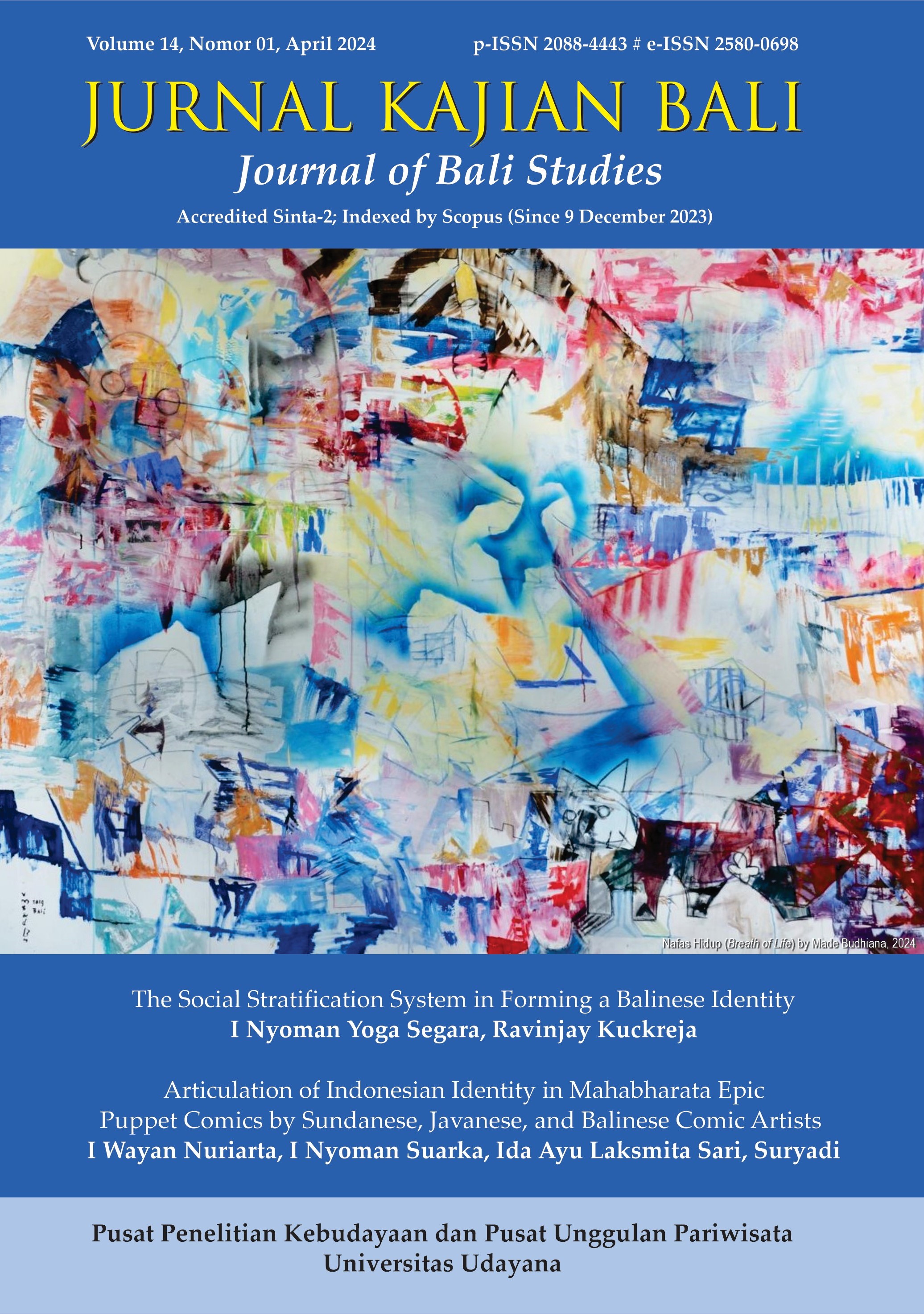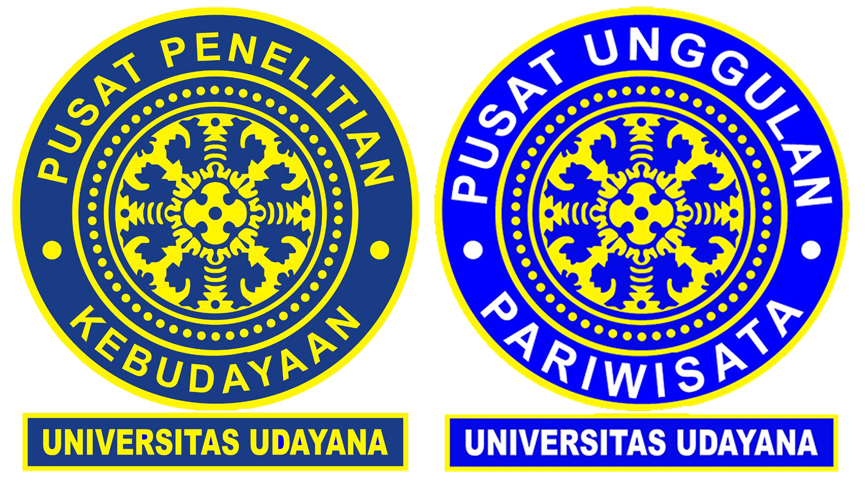The Social Stratification System in Forming a Balinese Identity
Abstract
This article defines the various layers and identity labels of the Balinese society. Much of their indigenous customs have been linked with Hinduism, and many would regard the two to be inseparable. This article, however, attempts to separate the indigenous elements of ancestral worship from the Vedic or Hindu understanding of societal divisions in order to properly study the two and how they influence one another. The history of the island has enforced the rigid caste system, but the application of Hindu philosophy serves an idealized definition of caste. In such a way, the Hindu or Vedic belief does provide much relief for Balinese society. However, they are still defined by their patrilineal heritage, and are bound to ancestral worship as per their indigenous religion. Fueled by the contemporary socio-political landscape of Bali, there is a need to properly define what Balinese identity actually is.
Downloads
References
Hobart, M. (2022). Cultural Studies and Everyday Life: A Balinese Case. Jurnal Kajian Bali (Journal Of Bali Studies), 12(2), 627-647. doi:10.24843/JKB.2022.v12.i02.p15
McDaniel, J. (2010). Agama Hindu Dharma Indonesia as a New Religious Movement: Hinduism Recreated in the Image of Islam. In Nova Religio: The Journal of Alternative and Emergent Religions, 14(1), 93–111. https://doi.org/10.1525/nr.2010.14.1.93
Dana, I N., ed. (2005). Kompilasi Dokumen Literer 45 Tahun Parisada. Jakarta: Parisada Hindu Dharma Indonesia Pusat.
Howe, L. (2004). Hinduism, identity, and social conflict: the Sai Baba movement in Bali. In M. Ramstedt (Ed.), Hinduism in Modern Indonesia (pp. 264–281). New York: Routledge.
Atmaja, J. (2008). Bias Gender Perkawinan Terlarang Pada Masyarakat Bali. Denpasar: Udayana University Press.
Korn, V.E. (1983 [1932]). Hukum Adat Bali. Terjm. I Gde Wayan Pangkat dari Het Adatrecht van Bali. Denpasar: Pemda Bali.
Geertz, H. & Geertz, C. (1975). Kinship in Bali. Chicago: University of Chicago Press.
Wiana, I K. & Santeri, R. (1993). Kasta dalam Hindu Kesalahpahaman Berabad-Abad. Denpasar: Yayasan Dharma Naradha.
Segara, I N. Y. (2015). Perkawinan Nyerod: Kontestasi, Negosiasi, dan Komodifikasi di atas Mozaik Kebudayaan Bali. Jakarta: Saadah Pustaka Mandiri.
Dumont, L. (1981). Homo Hierarchicus: The Caste System and Its Implications. Chicago: University of Chicago Press.
Picard, M. (2006). Bali Pariwisata Budaya dan Budaya Pariwisata. Terjm. Jean Couteau dan Warih Wisatsana dari Bali: Tourism Culturel et culture tourisque, 1992. Jakarta: Forum Jakarta-Paris.
Nordholt, H. S. (2009). The Spell of Power. Terjm. Ida Bagus Putrayadnya dari The Spell of Power: A History of Balinese Politics 1650-1940, 1996. Denpasar: Pustaka Larasan.
Kerepun, M. K. (2007). Mengurai Benang Kusut Kasta Membedah Kiat Pengajegan Kasta di Bali. Denpasar: Empat Warna Komunikasi.
Howe, L. E.A. (1984). God, People, Spirit and Witches: The Balinese System of Person Definition. BKI.
Agung, A. A. G. P. (2001). Perubahan Sosial dan Pertentangan Kasta di Bali. Yogyakarta: Yayasan Untuk Indonesia.
Notiasa, I W. (2005). Pemunculan Sistem Soroh dan Implikasinya Terhadap Kehidupan Masyarakat Desa Bali Aga (Studi Kasus di Desa Pakraman Sidatapa, Banjar, Buleleng, Bali). Tesis. Denpasar: Program Pascasarjana Univ. Hindu Indonesia.
Ratnatha, M. (2008). Babab Catur Warga ”Soroh” di Bali. Denpasar: Damai Sejati.
Singgin, I N. (1994). Leluhur Orang Bali, disusun. Bangli: Yayasan Widya Shanti.
Sastrodiwiryo, S. (1999). Perjalanan Danghyang Nirartha. Denpasar: Bali Post.
Ardhana, I., & Wardi, I. (2022). Adat, People Power and Religious Values: Sources of Social Resilience from the Early to Middle 19th Century in Bali. Jurnal Kajian Bali (Journal Of Bali Studies), 12(1), 223-242. doi:10.24843/JKB.2022.v12.i01.p11
Tim Penyusun. (1955). Monografi Pulau Bali. Jakarta: Pusat Djawatan Pertanian Rakjat.
Tim Penyusun. (1985). Monografi Daerah Bali. Denpasar: Pemda Tk. I Bali.
Tim Penyusun. (1986). Sejarah Bali. Denpasar: Proyek Penyusunan Sejarah Bali Pemda Tk. I Bali.
Agung, I. A. A. G. (1989). Bali Pada Abad XIX. Yogyakarta: Gadjah Mada University Press.
Wiana, I K. (2006). Memahami Perbedaan Catur Varna, Kasta dan Wangsa. Surabaya: Paramita
Soebandi, K. (2003). Babad Pasek Maha Gotra Pasek Sapta Rsi. Denpasar: Manikgeni.
Soebandi, K. (2009). Pasek (Asal Usul dan Peran Warga Pasek Masa Lampau). Denpasar: Kayumas.
Tim Penyusun. (2001). Hasil-Hasil Mahasabha VIII. Parisada Hindu Dharma Indonesia.
Tim Kompilasi. (2005). Kompilasi Dokumen Literer 45 Tahun Parisada. Parisada Hindu Dharma Indonesia.
Maswinara, I W. (1997). Bhagawad Gita. Surabaya: Paramita.
Pudja, I G. & Sudharta, T. R. (1973). Manawa Dharma Sastra. Jakarta: Lembaga Penerjemah Kitab Suci Indonesia.
Srinivas, MN. (1962). Caste in Modern India and Other Essays. London: Asia Publishing House.
Millar, S. B. (2009). Perkawinan Bugis. Refleksi Status Sosial dan Budaya di Baliknya. Terjm. Tim Penerjemah Ininnawa dari Bugis Weddings: Ritual of Social Location in Modern Indonesia. Makassar: Ininnawa.
Arsana, I G. K. Gde., et all. (1986). Dampak Modernisasi Terhadap Hubungan Kekerabatan di Daerah Bali. Jakarta: Depdikbud, Direktorat Sejarah dan Nilai Tradisional Proyek Inventarisasi dan Dokumentasi Kebudayaan Daerah Bali.
Surayin, I. A. P. (2002). Manusa Yajna. Surabaya: Paramita.
Sudharta, T. R. (2006). Manusia Hindu: Dari Kandungan Sampai Perkawinan. Denpasar: Yayasan Dharma Naradha.
Hoeve, W. van. (1960). Bali, Studies in Life, Thought and Ritual. Selected Studies on Indonesia, Vol. 5. The Hague & Bandung.
Kusuma, A. et all. (2009). Putru Astika Caritra. Bali: Kayumas Agung.
Fromm, E. (2007). Cinta, Seksualitas, dan Matriarki, Kajian Komprehensif Tentang Gender. Terjm. Pipiet Maizier dari Love, Sexuality and Matriarchy about Gender, 1997. Jakarta: Gramedia Pustaka Utama.
Artadi, I K. (2009). Hukum Adat Bali dan Aneka Masalahnya. Denpasar: Pustaka Bali Post.
Panetje, Gde. (N.d.). Aneka Catatan Tentang Hukum Adat Bali. Denpasar: Kayumas.
Boon, J. A. (1977). Anthropological Romance of Bali 1597-1972, Dynamic in Marriage and Caste Politics and Religion. Cambridge: Cambridge University Press.
Foucault, M. (1997). Seks & Kekuasaan, Sejarah Seksualitas. Terjm. Rahayu S. Hidayat dari Histoire de la Sexualite I: La Volonte de Savoir. Jakarta: Gramedia Pustaka Utama.
Putrawan, I N. (2005). Skandal Seks Raja-Raja Bali. Majalah Sarad.
Pudja, G. (1975). Pengantar Tentang Perkawinan Menurut Hukum Hindu. Jakarta: Mayasari.
Stuart-Fox, D J., (2010). Pura Besakih: Pura, Agama, dan Masyarakat Bali. Terjemahan Ida Bagus Putra Yadnya dari Pura Besakih: Temple, Religion and Society in Bali. Denpasar: Pustaka Larasan.
Chakravarti, U. (1993). Conceptualising Brahmanical Patriarchy in Early India: Gender, Caste, Class and State. Economic and Political Weekly, 28(14), 579–585. http://www.jstor.org/stable/4399556
Vaid, D. (2014). Caste in Contemporary India: Flexibility and Persistence. Annual Review of Sociology, 40, 391–410. http://www.jstor.org/stable/43049541

This work is licensed under a Creative Commons Attribution 4.0 International License.



















